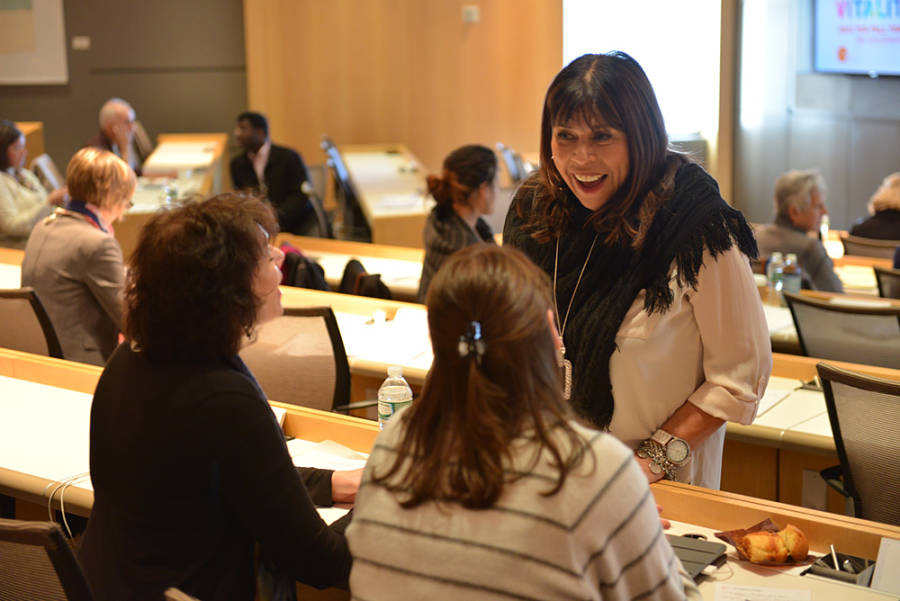So let’s lead, California. Let’s look beyond our borders to find work and share work. Let’s look at aesthetics. Let’s think of big ideas to make our work at the center of our civil society
—From Diane Rodriguez’s keynote at Theatre Bay Area’s April 2016 conference
I first met Diane Rodriguez at a 2007 orientation session for TCG’s New Generations Future Leaders program, which paired emerging leaders with seasoned mentors in theatres across the U.S. Diane, whose long relationship with TCG included participation in the NEA Career Development Program for Directors and Designers, was mentoring Jesus A. Reyes at L.A.’s Center Theatre Group. We were sitting in a conference room introducing ourselves and our relationship to TCG and the field. When it was Jesus’s turn, he talked about how important American Theatre magazine had been to him throughout his career. Diane, sporting bright orange lipstick, turned to me with a sly smile and said, “That’s funny. I never read American Theatre.”
Ironically, the last time Diane and I spoke, she was working on a piece for this magazine. It was mid-February, and I was in Fujairah, United Arab Emirates, for an International Theatre Institute executive meeting and the Fujairah International Arts Festival. It was 7 a.m. Saturday for me, 7 p.m. Friday for Diane in L.A. Face to face on Zoom, I gave her some feedback on the piece; she said she’d revise accordingly. A few weeks later, I received word that Diane had suffered a stroke, but was stable and doing okay, and she wanted me to know that she still intended to finish the article.
Diane joined TCG’s board in 2008 and served as its president for three years starting in 2013. I saw in her a visionary, fearless and intensely inventive. She saw structural barriers to making our theatres stronger, in aesthetics, equity, and community engagement. Knowing Diane was like inhabiting an adventure story whose protagonist hatches big plans and invites you to come along. Even if you hesitate, you end up saying, “Okay, yes—let’s go.” And you go.
One of her first such invitations was to join the Women’s Working Group, a cohort of artists, managers, presenters, and producers who meet annually in a variety of locales. I’ve been part of it ever since. Later that year, Diane pulled me aside and said that composer Sage Lewis was organizing a trip to Cuba, where his hybrid film/theatre piece The Closest Farthest Away was premiering at the Havana International Film Festival. “Do you want to go?” she asked me, eyes flashing. “Let’s go!” At the time, most U.S. citizens were banned from travel to Cuba, but were able to go under a professional research license. So we said yes to Sage, his wife Aleigh, and their collaborators at Project Por Amor, and off we went. It was the adventure of a lifetime. We saw films and theatre; met Flora Lauten, founder/artistic director of Teatro Buendia; and attended that company’s version of Frederick Dürrenmatt’s The Visit. We learned about the history of the revolution, and we drank rum on the Malecón. TCG followed that trip with two more delegations to Cuba.
With her deep awareness of the barriers that can constrain aesthetics, equity, and civic accountability, Diane championed the idea of combining producing and presenting in season planning, to expand the opportunities for both artists and audiences. As we began to program our 2011 National Conference in L.A., Diane called me and asked, “What do you think about offering a pre-conference for producing theatres whose leaders want to learn more about presenting national and global work?” The field was finally emerging from the crash of 2008, and our conference theme was “What If…?” So it was a perfect time to consider new models. After a few more calls, Mark Murphy, then at REDCAT; Mark Russell, of the Public Theater’s Under the Radar Festival; and Olga Garay-English, then of the L.A. Dept. of Cultural Affairs, were on board. And presto: RADAR LA was born. As it evolved, it became not only a pre-conference for presenters but a festival of 15 works from the U.S., Chile, Australia, Japan, and Mexico. Within the same timeframe, the Asian American Theater Conference and Festival, the Hollywood Fringe, the Annenberg/NEA Institute for theatre journalists were part of the action. Also at this TCG Conference, Latinx theatres gathered in what was a precursor to the Latinx Theatre Commons, an organization Diane was also part of and proud of. Reed Johnson’s conference preview for the Los Angeles Times was colorfully titled “‘Theaterpalooza’ hits L.A. area in June.”
These kinds of things happened with Diane. She was a big thinker, a tireless collaborator, a bridge-builder, and a doer. She had that twinkle in her eye.
I wonder what she’d be thinking and doing during the COVID-19 crisis, knowing theatres would close for indeterminate lengths of time. That the very idea of coming together in rooms to rehearse or attend a show would be temporarily forbidden. This is a moment Diane would have been both heartbroken over and ready to seize. Because the necessary rebuilding in the months and years ahead will also allow us to rethink the landscape of how we produce, present, and equitably fund our art form in the future. She would have had ideas, big and small. And she would have acted upon them. I know I’ll keep her adventurous spirit close to my mind and heart as we face down the uncertain times and radical rethinking ahead. In honor of Diane, let’s go!


